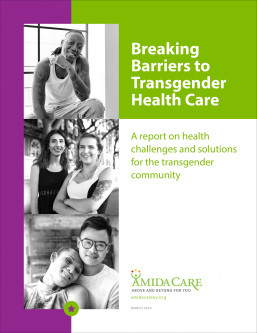Transgender Americans face widespread discrimination—in employment, housing and medical care, for example—and they’re often subjected to violence and trauma, all of which leads to poor health. For example, 19 percent of transgender people have reported being denied health care treatment because of their gender identity, and in 36 states, health insurance plans are allowed to exclude coverage of gender-affirming services. All of this contributes to the alarming fact that transgender women are 49 times more likely to be living with HIV. What can be done to break down the barriers to better health for people of trans experience?

The cover of Amida Care’s reportCourtesy of Amida Care
A new report from Amida Care, a health plan for people living with or at higher risk of contracting HIV, takes a more detailed look at these challenges and offers some solutions. Titled Breaking Barriers to Transgender Health Care, the free 16-page report can be downloaded here.
According to an Amida Care press release, recommendations outlined in the report include:
- Implementing cultural competency trainings for all health provider staff, including physicians, individuals in administrative and support roles and individuals who work at insurance plans;
- Affirmatively hiring transgender individuals as staff in living-wage jobs;
- Updating forms, surveys and other materials to include gender markers that allow people to self-identify;
- Mandating health insurance coverage for gender-affirming care for transgender employees in private and public sector jobs; and
- Passing and enforcing anti-discrimination policies in housing and employment, such as the Equality Act of 2017.
“At Amida Care, we believe in caring for the whole person, which means providing access to primary care, hormone therapy, gender-affirming surgeries, sexual health services, HIV treatment and prevention, substance use treatment and mental health services for our transgender members,” said Kevin Steffens, RN, MBA, vice president of clinical services and programs at Amida Care in the press release. “There is a great need for increased community resources for transgender people, particularly for those who don’t have a strong network of supportive family and friends.”







Comments
Comments